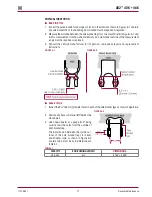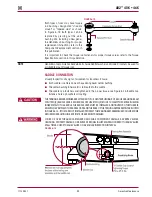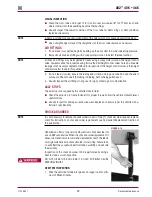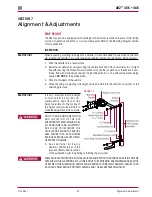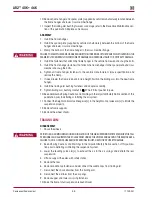
Preventive Maintenance
22
17730-241
AR2
™
40K • 46K
FRAME HANgER TO TRAILINg ARM CONNECTION
If more than half the thickness of the rubber of the trailing arm bushing is diminished replacement
is recommended . For trailing arm bushing replacement, refer to the Component Replacement
section in this publication .
FIguRE 6‑11
■
The flat must be positioned vertically as
shown in Figure
6-11 . If the flat of the
adapter position is incorrect, removal of
the fasteners will be necessary to cor-
rect position .
pHYSICAL INSpECTION
IF TRAILING ARM BUSHING MOVEMENT OR
LOOSENESS IS NOTED IN THE TRAILING ARM
END HUB, DO NOT OPERATE THE VEHICLE .
REPLACE THE RUBBER TRAILING ARM
BUSHINGS AND ALL CONNECTING PARTS . THE
ABOVE CONDITION CAN RESULT IN COSTLY
REPAIR, DOWNTIME, POSSIBLE SEPARATION
OF COMPONENTS, ADVERSE VEHICLE HANDLING, PROPERTY DAMAGE, OR PERSONAL INjURY .
1 . If trailing arm bushing movement or looseness is detected in the trailing arm end hub,
dO NOT
operate the vehicle . Replace the trailing arm bushings and all connecting parts . Refer to the
Component Replacement section of this publication .
2 . Check and record torque values, tighten 1" fasteners to 470 ± 25 foot pounds torque, see
Figure 6-11 .
LONgITudINAL ANd TRANSVERSE TORquE ROdS
THE AR2 SUSPENSION INCORPORATES LONGITUDINAL AND TRANSVERSE RODS FOR VEHICLE
STABILITY . IF THESE COMPONENTS ARE DISCONNECTED OR ARE NON-FUNCTIONAL, THE VEHICLE
SHOULD NOT BE OPERATED . FAILURE TO DO SO CAN RESULT IN ADVERSE VEHICLE HANDLING,
ADVERSE VEHICLE HANDLING, POSSIBLE TIRE CONTACT WITH THE FRAME, PREMATURE COMPONENT
DAMAGE, OR SEVERE PERSONAL INjURY .
All torque rods need to be inspected for looseness by one of the following methods .
■
Method 1
—
For Tractor applications only
with brakes applied, slowly rock the empty vehicle
with power while a mechanic visually checks the action at both ends
■
Method 2
— with the vehicle shut down, a lever check can be made with a long pry bar placed
under each rod end and pressure applied
Visually inspect torque rod bushings for torn or shredded rubber, inspect for bent, cracked, or
broken torque rods and also for end hubs that have an elongated “oval” shape . Any of these condi-
tions require component replacement . If there is metal-to-metal contact, this is a sign of excessive
bushing wear and the bushing needs to be replaced .
NOTE
The lengths of the torque rods are determined by the vehicle manufacturer . Refer to vehicle manu-
facturer’s service instructions for the proper torque rod length .
The lengths of these torque rods may be fine tuned by adding or removing shims at the straddle mount
end of the torque rods in order to correct drive line angles or axle centering under the frame . The
transverse torque rods center the axles under the frame and control axle walk-out during cornering .
A two-piece torque rod is also available to cut and weld to the desired length, see Hendrickson
publication No . 45745-148 .
The mounting brackets at the axle ends of the torque rods are furnished and welded into position
on the axle housings by the vehicle manufacturer or the axle manufacturer .










